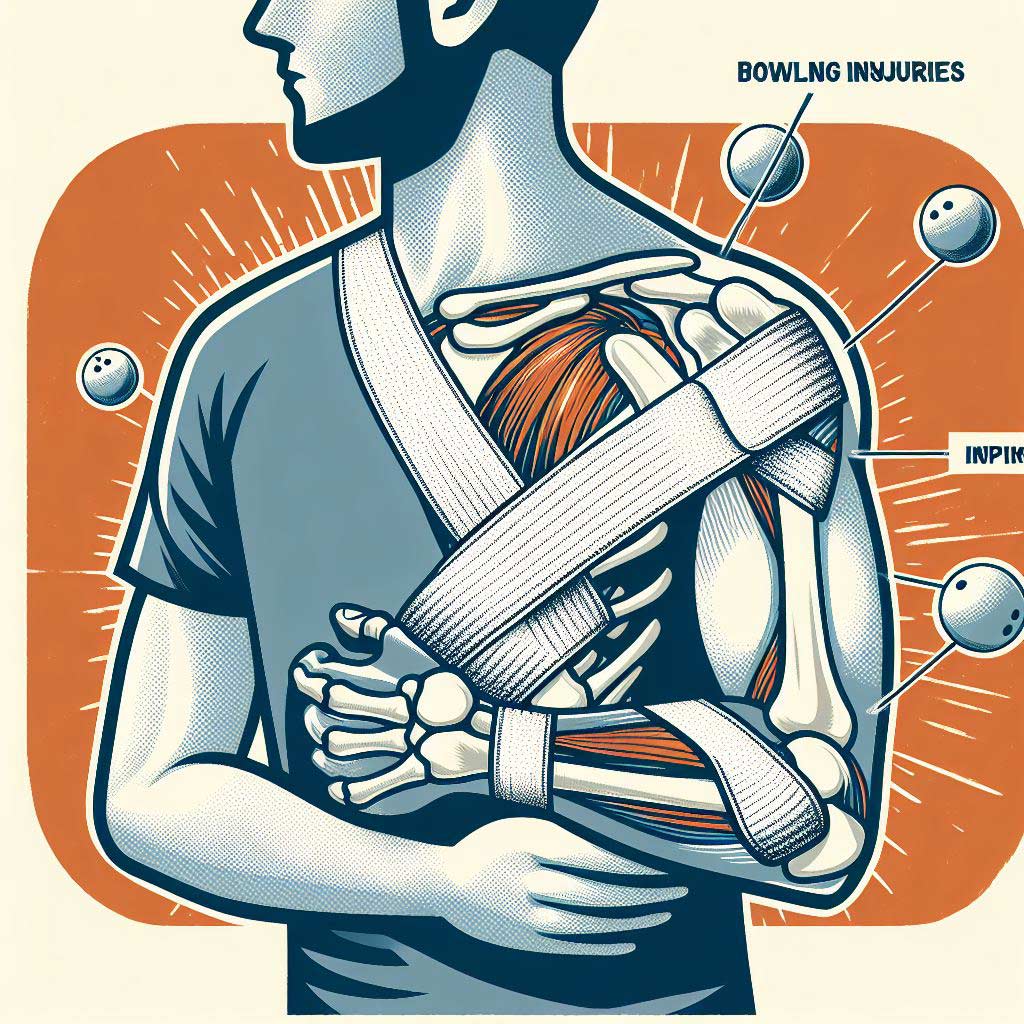Bowling is a popular sport that provides great physical activity and fun for over 70 million participants in the United States. However, the repetitive motion involved can place a lot of stress on the shoulder joint, making bowlers prone to overuse injuries. Shoulder pain and other bowling injuries can disrupt performance and take away enjoyment of the game.
The most common shoulder problems experienced by bowlers include rotator cuff injuries, bicep tendonitis, and adhesive capsulitis (frozen shoulder).
The pain and reduced shoulder mobility from these conditions can severely impact bowling form, accuracy, power, and endurance. It becomes difficult to swing the ball back, follow through properly, and bowl repeatedly without discomfort.
Fortunately, many bowling shoulder injuries can be prevented with proper form, strength training, and care. When injuries do occur, treatment focused on resting the joint, physical therapy, medication, and stretching/strengthening exercises can help bowlers recover and get back to pain-free bowling.
This article will explore the most typical shoulder injuries affecting bowlers, their causes and symptoms, treatment options, and tips to avoid injury in the first place through training and technique adjustments. With knowledge and vigilance, bowlers can take proactive steps to keep their shoulder healthy for the long run.
Rotator Cuff Injuries
The rotator cuff is a group of four muscles and tendons that surround the shoulder joint and stabilize the head of the humerus in the glenoid socket. The supraspinatus, infraspinatus, teres minor, and subscapularis muscles facilitate and control shoulder movements like raising the arm overhead and outward rotation.
During the bowling motion, the rotator cuff stabilizes the shoulder on the backswing, then contracts to slow and control the motion of bringing the arm forward to release the ball. Repeating this motion with poor form or muscle imbalance can cause rotator cuff impingement or tears.
Symptoms of rotator cuff injury include:
- Shoulder pain during or after bowling, especially when lowering or lifting the arm
- Tenderness in the front or outer shoulder
- Weakness and reduced range of motion
- Pain at night lying on the affected shoulder
- Crepitus or popping sensation when moving the shoulder
Rotator cuff injuries are often caused by:
- Repetitive stress from bowling without rest
- Bowling with improper form and mechanics
- Muscle tightness or imbalance around the shoulder
- Fatigue, which disrupts normal motion control
Treating rotator cuff injuries involves:
- Resting the shoulder fully from aggravating activities
- Ice and anti-inflammatory medication to relieve pain and swelling
- Physical therapy exercises to strengthen the cuff and improve flexibility
- Surgery for severe rotator cuff tears
With proper rest and rehabilitation focused on rotator cuff strengthening, most bowlers can fully recover and prevent re-injury. Using lighter bowling balls and adjusting technique can also take pressure off the cuff.
Bicep Tendonitis
The biceps muscle in the front of the upper arm has two tendon attachments in the shoulder. The main biceps tendon can become irritated and inflamed from overuse during bowling, resulting in anterior shoulder pain known as bicep tendonitis.
Common symptoms include:
- Aching pain and tenderness in the front of the shoulder
- Soreness and tightness in the biceps muscle
- Pain that increases with lifting or bending the elbow
- Swelling around the biceps groove
Bicep tendonitis is caused by:
- Repeated stress on the biceps tendon during the bowling motion
- Bowling with improper form and biomechanics
- Not warming up properly before bowling
- Shoulder instability or weakness in surrounding muscles
To treat bicep tendonitis:
- Apply ice packs to the sore front shoulder area
- Take anti-inflammatory medication to reduce swelling
- Rest the shoulder initially to allow healing
- Gently stretch and massage the biceps muscle
- Strengthen the rotator cuff and scapular stabilizers
- Use targeted exercises to increase biceps flexibility
With a period of rest, bicep tendonitis normally resolves within a few weeks. Ensuring proper mechanics when bowling and building strength in the shoulder can prevent the tendon from becoming overstressed again.
Adhesive Capsulitis (Frozen Shoulder)
Adhesive capsulitis, also referred to as frozen shoulder, involves the thickening and contraction of the shoulder joint capsule. This restricts the range of motion and causes progressive pain and stiffness in the shoulder. It is a common overuse injury among bowlers over 40 years old.
The symptoms of a frozen shoulder include:
- Gradual onset of shoulder pain and reduced mobility
- Severe stiffness and difficulty moving the arm
- Mild ache at rest worsening with movement
- Eventual pain interfering with sleep
Frozen shoulder develops from:
- Chronic inflammation and scar tissue formation in the shoulder capsule
- Intrinsic tightening of the capsule over time
- Possible autoimmune response causing contraction
- Diabetes is a risk factor for adhesive capsulitis
Treating a frozen shoulder involves:
- Physical therapy to improve range of motion and maintain strength
- Anti-inflammatory medication and cortisone injections to decrease inflammation
- Home stretching exercises between physical therapy visits
- Heat and massage to loosen the tissue and relax muscles
- Surgery in severe unresponsive cases to break up scar tissue
The natural course of a frozen shoulder is 12-18 months as the tissue slowly loosens and mobility improves. With a customized physical therapy program focused on the shoulder capsule, full motion can be restored.
Preventing Bowling Shoulder Injuries
The best medicine for bowling shoulder injuries is prevention. Bowlers can take several proactive steps to maintain healthy shoulders and avoid pain or dysfunction:
- Use proper bowling form – Don’t hyperextend the elbow or twist the arm on the backswing. Keep wrists straight and the ball close to the body.
- Build shoulder girdle strength and flexibility with weight training. Target the rotator cuff, deltoids, rhomboids, and trapezius.
- Stretch before and after bowling sessions. Warm tissues are less prone to strain.
- Strengthen core muscles for added stability around the shoulder joint.
- Take frequent breaks during long bowling sessions. Muscle fatigue strains in proper form.
- Use a lighter ball weight to reduce strain on the shoulder.
- Learn to relax the arm and avoid muscle tension when aiming and releasing.
- Allow for 1-2 rest days a week from bowling to recover.
- Warm up the shoulder thoroughly and cool down with light stretches.
With disciplined prevention habits, awareness of early warning signs, and quick response to any shoulder pain, bowlers can enjoy throwing strikes and spares without injury holding them back.
Conclusion
The repetitive nature of bowling can take a toll on the shoulder joint, making bowlers susceptible to painful overuse injuries. Common conditions like rotator cuff tears, bicep tendonitis, and adhesive capsulitis can restrict mobility and harm performance.
However, bowlers can take proactive steps to maintain healthy shoulders through proper strength training, form, rest, and care.
Being aware of injury mechanisms, risk factors, and early symptoms allows bowlers to modify activities before serious injury develops.
If shoulder pain does occur, treatment focused on rest, anti-inflammatory modalities, targeted rehabilitation exercises, and technique adjustments can help bowlers recover fully.
With knowledge, prevention, and timely response to pain, bowling enthusiasts can keep their shoulders strong for years of enjoying the sport.
Frequently Asked Questions
Can bowling hurt your shoulder?
Yes, bowling can definitely hurt your shoulder if you use improper form or bowl excessively. The repetitive overhead motion strains the rotator cuff and bicep tendon, leading to overuse injuries.
What is the most common injury in bowling?
Rotator cuff strains and tendonitis are the most frequent shoulder injuries in bowlers. The rotator cuff muscles and tendons become inflamed from repetitive stress.
How long does it take for a strained shoulder to heal?
A minor shoulder muscle strain usually takes 2-4 weeks to heal with rest, ice, and gentle stretching. More severe rotator cuff tears can take 2-3 months to fully recover with rehabilitation exercises.
What are symptoms of shoulder tendonitis?
Symptoms of shoulder tendonitis include pain and tenderness focused on the tendon, pain with movement in certain directions, stiffness, and reduced strength and range of motion.
How do you fix shoulder pain from bowling?
Rest the shoulder, apply ice, take anti-inflammatories, get physiotherapy exercises, use a compression sleeve, adjust bowling mechanics, strengthen the rotator cuff muscles, and improve posture/flexibility.
How do you get rid of shoulder pain after bowling?
Ice the shoulder, take NSAIDs, get a massage, stretch gently, use a heating pad, take a few days off from bowling, and make sure to warm up properly before your next session.
How do I know if I have damaged my rotator cuff?
Signs of a damaged rotator cuff include pain raising your arm overhead or outward, weakness in the shoulder, popping sensations, tenderness on the shoulder, and pain at night while sleeping.
What muscles are sore from bowling?
Bowling can make the rotator cuff muscles (supraspinatus, infraspinatus, subscapularis), biceps, deltoids, forearm flexors, and upper back muscles feel sore.
What is the shoulder injury for fast bowlers?
Fast bowlers in cricket are prone to rotator cuff strains and tears, bicep tendonitis, labral tears, and shoulder dislocations from the forceful repetitive throwing motion.





